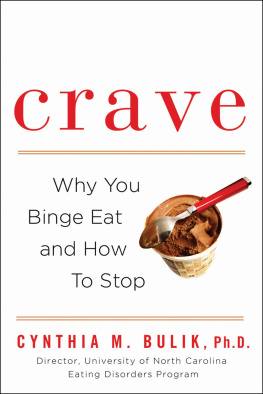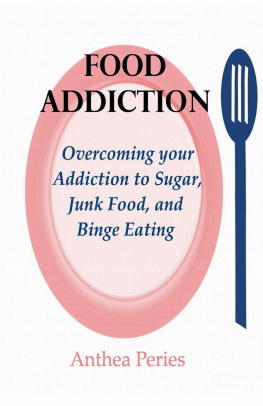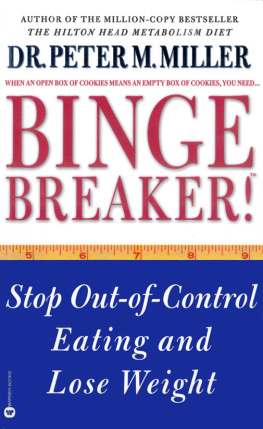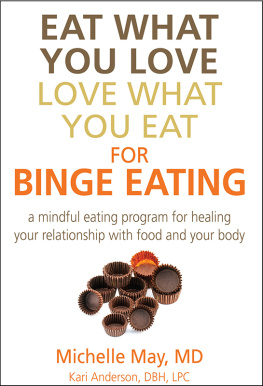crave
WHY YOU BINGE EAT AND HOW TO STOP
Cynthia M. Bulik, Ph.D.

This book is dedicated to my family, who understands andsupports my passion and my science, and to the countlessadvocates who are fighting on many fronts to destigmatizeeating disorders so that they can have the recognition,funding, and insurance coverage they deserve.
All matters regarding your health require medical supervision. This book is my personal statement on binge eating disorder, applying my decades of experience to this particular subject matter. It is neither intended nor designed to replace the opinions of your own qualified physician.
I have used my own research on binge eating disorder to bolster my opinions and assertions, and have incorporated the personal testimony of many patients to put a human face to this startling trend. To protect their privacy, however, I have used pseudonyms and, in some cases, for clarity or convenience combined the experiences of several similar patients into one composite character.
Contents
Binge eating tops the list of eating disorders affectingAmericans, with the first-ever national survey on eatingdisorders finding it much more prevalent thaneither anorexia or bulimia.
HEALTH DAY NEWS
Its a common scenario played out in millions of house holds around the country every single day: A woman eats her favorite ice cream straight from the carton until she reaches the bottom, or a man goes to his favorite sports bar and practically inhales twenty buffalo wings. Each is simply trying to satisfy intense, at times overwhelming, cravings. Some crave sweets, others pasta; whatever the target, it finds its way from hand to mouth.
Every binge is different, just as every craving is different and every binge eater is different, but the scenario is most often the same: Binge eaters like to be alone with their behavior, often turning to late-night, early-morning, or even what I call backseat binges to ensure that no one sees their so-called shameful activities, those times when the kids are asleep, the parents are out of town, the spouse is still at work, or the roommate has just left for that big business trip or is still taking her final exams.
My patients have told me countless horror stories of how far they went to conceal a binge: driving across city, county, or even state lines so no one they know will witness them going from fast-food restaurant to convenience store, or from drive-through to drive-through in record time. Some have even hidden in a closet with a grocery bag full of clandestine food.
Those willing to look a little beyond the carefully constructed faade might notice some telltale signs of a classic binge eater: snack-cake wrappers wedged between sofa cushions, caches of food hidden throughout the house, fast-food receipts stacked like Monopoly money in car glove compartments, and greasy wrappers littering the floorboards. But not everyone leaves a trail; some binge eaters spend as much time covering their tracks as they do shopping for the binge itself.
Regardless, the cravings can seem insatiable. Day or night, alone or with someone just in the next room, the binge eater can hardly refuse the cravings that cause him or her to ingest five hundred, a thousand, or even sometimes as many as five thousand or more calories in a single sitting.
The urges to eat are often as intense as they are spontaneous; later in this book we will talk about what triggers a mere craving or a full-fledged binge episode, but patients have told me that when it happens, for whatever reason, they feel powerless to resist the urge and often zone out while eating. So while the initial craving may be for food from a certain food group, restaurant, snack bar, or doughnut shop, what happens during the binge itself has very little to do with taste.
Recently a colleague of mine confessed to me that she was concerned that her husband might be a closet binge eater. When I asked her why she thought that, she admitted that she had caught him feasting on saltine crackers and mayonnaise in the middle of the night!
Clearly, binge eating is not merely the occasional craving of someone whos hungry, who may consume a handful of chips or a single doughnut. Binge eating involves the supersizing of cravings to the point of an uncontrollable urge that snowballs until the binge eater literally feels helpless to resist the urge to binge.
Binge eaters dont just consume a handful of potato chips; theyll down a whole bag in a sittingand that may be just a teaser for the grand finale thats to come. A bowl of ice cream may be just the appetizer for the whole pintand then another, if its handy or if theres a convenience store within easy driving distance. A single doughnut? Forget it; the binge eater wants six and, stomach swollen, blood sugar skyrocketing, will contemplate getting in the car and heading to the nearest drive-through to make it an even dozen.
Binge eating disorder is classified by a distinct and measurable pattern of behavior that has manifested itself in the individuals life, often over many months or years. Does this sound like someone you know or love?
Maybe a lot like... you?
Then were both right where were supposed to be. My name is Cynthia Bulik, Ph.D., and I am the director of the Eating Disorders Program at the University of North Carolina at Chapel Hill. It is my mission to inform as many people as possible about the dangers of binge eating, to help those who already feel trapped to escape, and to prevent others from falling into the dangerous cycle of binge eating. Be it prevention or treatment, success is my ultimate goal.
As so often happens in the field of medicine, my interest in binge eating came about through a combination of happenstance and career path. After receiving my bachelors degree from the University of Notre Dame and my masters degree and doctorate from the University of California at Berkeley, I became interested in eating disorders while researching childhood depression. Mood and food are so intricately intertwined, and it seemed whenever I was doing research on depression I was reading about appetite and weight, and whenever I was working on eating disorders, I was hearing about depression and anxiety. We know these systems are linked in our psychology, but we are now discovering that they are also linked in our biology.
Why You Binge EatAnd How to Stop
If you are a binge eater youre not alone, not anymore. Thanks to decades of research in the field, hundreds of patient case studies, and reams of research conducted on this very topic, I have the resources to help you get the upper hand on your own binge eating, and together we can conquer the problem.
Binge eating disorder is a highly treatable condition. When we give patients behavioral tools to curb the crave at our program at UNC, most of those who use them canand dotriumph over their binge eating. You will hear about these patients, men and women, young and old, and how they conquered their disorder using a variety of strategies in their personal arsenal; you will learn these strategies as well.
What about gaining weight? I know how closely linked concerns over weight and binge eating are, and that is why for anyone trying to get control over their binge eating losing weight and keeping it off are a critical part of both treatment and self-discovery. Once you can to identify the causes of your cravings, it becomes easier to lose weight as well as to bring your binges under control.
Across the country, many effective forms of treatment exist to help sufferers overcome their disorder, including:
Next page









